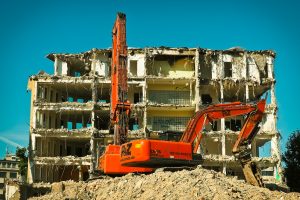 Print a Sign-In Sheet | Spanish Version
Print a Sign-In Sheet | Spanish Version
Demolition work is a very hazardous construction activity and can cause serious and even fatal accidents if not completed properly. OSHA standard 29 CFR 1926 Subpart T outlines the regulations for demolition work in the construction industry.
Demolition Safety Tips:
- Prior to the start of demolition operations, an engineering survey of the structure must be completed by a competent person. The survey should determine the condition of the framing, floors, and walls of the structure and should review the possibility of an unplanned collapse during the demolition process.
- If employees must enter a structure that has been damaged, make sure all walls and floors of the structure are properly braced and shored.
- Make sure all employees wear appropriate personal protective equipment (PPE) while working in the damaged structure (i.e. hard hat, safety glasses, reflective vest, hearing protection, and other PPE as required).
- Inspect and maintain all walkways, stairs, and ladders for slip, trip, and fall hazards. Properly illuminate these areas. Verify that all means of egress are unobstructed and all employees are trained over proper evacuation routes in case of an emergency.
- Shut off or cap all electric, water, gas, sewer, and other utilities supplied to and from the structure. Make sure you have notified all of the utility companies of this action. If it is necessary to maintain any utilities during demolition, relocate the lines or protect them as needed.
- Guard all wall openings to a height of 42 inches.
- Cover and secure all floor openings with a material that can support the weight of any load which may be imposed on the floor.
- Floor openings that are used for material disposal must be enclosed and barricaded (not less than 42 inches high and not less than 6 feet from the projected edge of the opening above). Floor opening used for material disposal must not be more than 25% of the total floor area. Warning signs pointing out the potential for falling material must be posted at each level and debris removal at the lower level should not be permitted until operations from the top level cease.
- Start the demolition process at the top of the structure and proceed downward. Do not cut or remove structural or load-supporting members on any floor until all stories above that floor have been removed. Remove any stone work or roof cornices prior to pulling walls down. It is important to try and control the collapse as much as possible.
- During mechanical demolition, no workers shall be permitted in any area when using a wrecking ball or clam shell to remove debris.
- During demolition work, the competent person must conduct continuing inspections to detect hazards resulting from weakened floors and walls. If hazards are found, employees must be removed and not allowed back in the area until the hazards have been corrected.
- Try to limit the number of people to the demolition area and ensure all communication systems are working properly.
KEMI does not assume liability for the content of information contained herein. Safety and health remain your responsibility. This information is to be used for informational purposes only and not intended to be exhaustive or a substitute for proper training, supervision or manufacturers’ instructions/recommendations. KEMI, by publication of this information, does not assume liability for damage or injury arising from reliance upon it. Compliance with this information is not a guarantee or warranty that you will be in conformity with any laws or regulations nor does it ensure the absolute safety of any person, place or object, including, but not limited to, you, your occupation, employees, customers or place of business.

